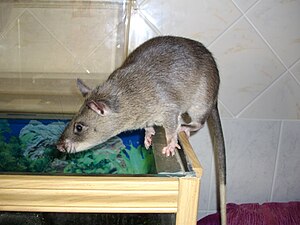Giant hamster rats
| Giant hamster rats | ||||||||||||
|---|---|---|---|---|---|---|---|---|---|---|---|---|

Gambian hamster rat |
||||||||||||
| Systematics | ||||||||||||
|
||||||||||||
| Scientific name | ||||||||||||
| Cricetomys | ||||||||||||
| Waterhouse , 1840 |
The giant hamster rats ( Cricetomys ) are a genus of very large African rodents that live in rainforests and bushland.
description
With a head body length of up to 45 cm and a tail that is just as long, they are twice to three times as large as other representatives of the hamster rats . Males reach a weight of 2.5 kg, females weigh 1.4 kg. The fur is gray-brown or red-brown on top and white on the underside. The big ears and the tail are bare.
Originally six species of this genus were described, but the rodent specialist John Ellerman summarized these in 1941 to a single species, whose varieties would have at most the status of subspecies. In 1967 this one type was again divided into two types by Huguette Genest-Villard:
- Gambian hamster rat or Gambian rat, Cricetomys gambianus
- Giant Emin Hamster Rat , Cricetomys emini
Giant hamster rats are omnivores. They feed on all kinds of plant materials, insects , snails and even feces. Much food is stowed in the cheek pouches and then stored in the buildings.
As loners, giant hamster rats are extremely aggressive towards their peers. If you lock two males together, they fight to the death of one of the opponents. These animals reproduce several times a year; some individuals are likely to have offspring ten times a year. A litter consists of one to five, usually four, young. The lifespan can be over seven years in captivity, but is likely to be much shorter in the wild.
Occurrence
The Gambian hamster rat inhabits savannahs across sub-Saharan Africa. The Emin giant hamster rat inhabits the rainforests of West and Central Africa . Both species are nocturnal and mostly hide in thickets and undergrowth. You can build burrows yourself, but prefer natural openings such as knotholes or termite burrows. Giant hamster rats are good at climbing and swimming.
Spread
In some cities in West Africa, giant hamster rats now inhabit the sewers and are considered to be just as much pests as brown rats . However, this is not the case in all of Africa; in South Africa the animals avoid human proximity and are considered to be rarities.
The animals also reproduce in captivity, are inexpensive to feed and are therefore raised in rural areas on a local scale as food for their own use or for sale in markets. To accommodate them, some vertical oil drums are used, with a round hole cut in the middle of the lid.
Neozoa
The ease of keeping pets has also resulted in export to the United States . Released and feral specimens have multiplied rapidly and spread over much of the United States. The giant hamster rats are one of the invasive species in the USA .
Giant hamster rats and humans
Giant hamster rats are also of interest to entomologists , as they are the hosts of the parasitic insect group Hemimerina , which eat scales and fungal coatings on the skin of the animals. These insects are placed near the earwigs and are not found on any other mammal.
Giant hamster rats are trained in sub-Saharan Africa to detect tuberculosis in humans. Preliminary experiments suggest that the rats could test 150 saliva samples for tuberculosis in 30 minutes. The microscope can currently examine 20 samples per day. In 2003 the World Bank made $ 165,000 available for further exploration.
You will also be trained to track down land mines . Compared to mine detection dogs, they are easier to breed, feed and transport, and their low body weight prevents them from triggering mines. The training period is six to twelve months. The animals have been used by Apopo for mine clearance in Mozambique since the turn of the millennium , in Thailand since 2010 and in Cambodia since 2015 .
Giant hamster rats were carriers of a monkeypox epidemic in humans in the American Midwest in 2003 . In this case, the infected animals were imported from Africa as zoo and domestic animals.
See also
African trypanosomiasis, epidemiology section
literature
- Ronald M. Nowak: Walker's Mammals of the World. 2 volumes. 6th edition. Johns Hopkins University Press, Baltimore MD et al. 1999, ISBN 0-8018-5789-9 .
- H. Genest-Villard: Révision du genre Cricetomys (Rongeurs, Cricetidae). In: Mammalia. Vol. 31, Issue 3, 1967, ISSN 0025-1461 , pp. 390-455, doi : 10.1515 / mamm.1967.31.3.390 .
Web links
- Illustration of a Gambia rat
- APOPO - We train rats to save lives. Use of giant hamster rats to search for land mines and to detect TB
- Giant rats evaluate tuberculosis samples. Press release, December 17, 2003
Individual evidence
- ^ Alessandro Finzi: Integrated Backyard Systems. A Contribution to the Special Program for Food Security. Animal Production Department, University of Tuscia, Viterbo (Italy). FAO 2000. Chapter 7: Backyard small species.
- ↑ Innovations Report: Giant hamster rats evaluate tuberculosis samples
- ↑ Ronaldinho eats his way through the minefield. FAZ, September 2, 2009
- ^ Training Rats to Detect Land Mines. Solutions Online, April 2012
- ↑ Linda Poon: Yes, Rats Are Being Trained to Sniff Out Land Mines. Citylab.com, July 20, 2015
- ↑ YJF Hutin, RJ Williams, P. Malfait, et al .: Outbreak of Human Monkeypox, Democratic Republic of Congo, 1996-1997. Emerging Infectious Diseases, 7, 3, 2001.
- ^ Centers for Disease Control (CDC), Morbidity and Mortality Weekly Report. Atlanta, Georgia. MMWR, 52, 27, pp. 642-646, 2003

